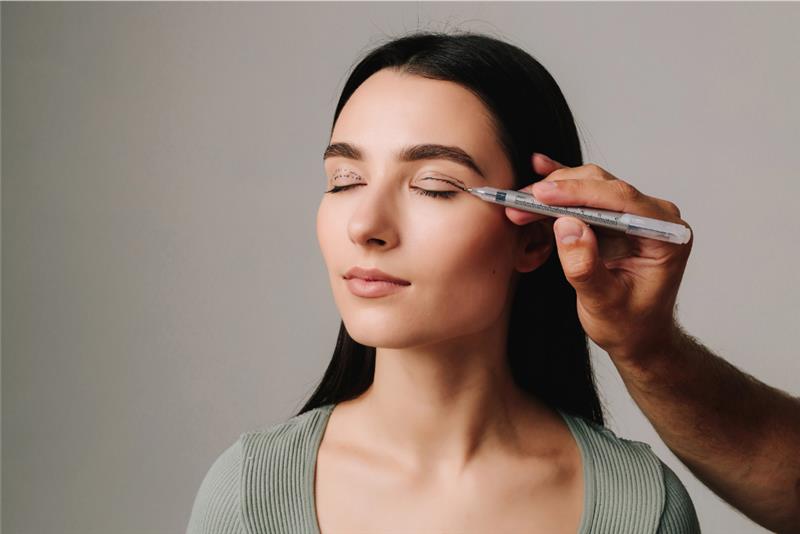For some, these drooping lids are more than just a cosmetic concern; they can obstruct vision and impact daily life. If you’ve battled heavy, tired-looking eyes, blepharoplasty aka an eyelid lift might be the solution you’ve been searching for.
What Causes Sagging Eyelids?
Several factors contribute to the development of sagging eyelids.
Natural Aging Process
As we age, the skin naturally loses collagen and elastin, the proteins responsible for its firmness and elasticity. This loss causes the skin around the eyes to become lax and droop.
Genetics
Some individuals are genetically predisposed to developing droopy eyelids earlier in life. You might notice a family history of this trait.
Environmental Factors
External aggressors like prolonged sun exposure and smoking can accelerate the breakdown of collagen and elastin, contributing to premature sagging. Lifestyle choices, such as poor diet and lack of sleep, can also play a role.
Fatigue and Swelling
While usually temporary, periods of significant fatigue or fluid retention can exacerbate the appearance of heaviness and puffiness around the eyes.
Medical Conditions
In some cases, droopy eyelids can be a symptom of a medical condition like ptosis, which involves a weakening of the muscles that lift the upper eyelid, or other underlying health issues.
How Sagging Eyelids Affect Appearance and Vision
Cosmetic Effects
- Tired, aged look: Drooping upper eyelids and under-eye bags can create a perpetually tired and older appearance, even when you feel rested.
- Puffiness and heavy upper lids: Excess skin and fat can accumulate in the upper and lower eyelids, leading to a heavy, puffy appearance.
- Makeup application challenges: Sagging upper lids can make applying eye makeup difficult, and the results may not be as desired.
Functional Effects
- Obstructed peripheral vision: In severe cases, drooping upper eyelids can hang low enough to obstruct the upper and outer fields of vision, making tasks like driving or reading challenging.
- Eye strain and fatigue: Constantly trying to lift heavy eyelids can lead to eye strain, headaches, and overall fatigue.
- Difficulty with reading or driving: The visual obstruction can directly impact the ability to perform everyday tasks that require clear vision.
What Is Blepharoplasty?
Blepharoplasty is a surgical procedure, commonly referred to as eyelid surgery for sagging eyelids, designed to remove excess skin, muscle, and sometimes fat from the upper and/or lower eyelids.
There are two main types of blepharoplasty. Here are the differences between upper vs. lower blepharoplasty:
- Upper Blepharoplasty: This procedure focuses on the upper eyelids, addressing drooping skin that may be obscuring the natural crease or even impacting vision.
- Lower Blepharoplasty: This targets the lower eyelids, aiming to reduce puffiness, eliminate under-eye bags, and smooth out wrinkles in this area.
The procedure itself is typically performed on an outpatient basis, meaning you can return home the same day. During the surgery, a skilled surgeon makes minimal incisions, strategically placed within the natural creases of the eyelids to minimize visible scarring.
Depending on the extent of the surgery and patient preference, local anesthesia with sedation or general anesthesia may be used.
Benefits of Blepharoplasty
The benefits of blepharoplasty are multifaceted, offering both aesthetic and functional improvements:
Aesthetic Improvements
- Restores youthful, refreshed appearance: By eliminating excess skin and fat, blepharoplasty creates a more alert and youthful look around the eyes.
- Smoother eyelid contour: The procedure refines the eyelid contours, reducing heaviness and puffiness.
- Enhanced eye shape and symmetry: Blepharoplasty can improve the overall shape and symmetry of the eyes, creating a more balanced facial appearance.
Functional Improvements
- Unobstructed vision field: For individuals with significant upper eyelid drooping, blepharoplasty can lift the lids and restore a full field of vision.
- Reduced eye fatigue: By removing the excess weight of sagging eyelids, the procedure can alleviate eye strain and fatigue.
- Easier application of makeup or glasses use: A smoother upper eyelid provides a better surface for makeup application, and lifted lids can prevent interference with glasses.
Beyond the physical improvements, a rejuvenated appearance can lead to a significant boost in confidence and self-esteem.
Who Is a Good Candidate for Blepharoplasty?
You might be an ideal candidate for blepharoplasty if you have:
- Droopy upper eyelids that impair vision or aesthetics.
- Puffy lower eyelids or under-eye bags.
- Healthy individuals without serious eye conditions. Certain pre-existing eye conditions may be contraindications for surgery.
- Realistic expectations about results. It’s important to understand that blepharoplasty can significantly improve the appearance of the eyelids but may not address other signs of aging on the face.
The most important step in determining your candidacy is to schedule a thorough consultation with a qualified and experienced surgeon. In Los Angeles, Newport Beach, or Beverly Hills, it’s necessary to find the best eye surgeon for blepharoplasty in Los Angeles who can evaluate your eye health, discuss your goals, and determine if this procedure is right for you.
Consulting with an ophthalmologist for eyelid surgery or a top-rated eye surgeon ensures you are in the hands of a specialist with extensive knowledge of the delicate eye area.
While a general eye doctor for droopy eyelids can provide an initial assessment, a surgical specialist is necessary for discussing and performing blepharoplasty.
What to Expect During and After Surgery
Pre-surgical Evaluation
Before undergoing blepharoplasty, you will have a comprehensive pre-surgical evaluation. This typically includes:
- A thorough eye exam and health history review.
- A detailed discussion of your goals, expectations, and the potential outcomes of the surgery.
The Procedure
The blepharoplasty procedure itself is usually completed within 1–2 hours. The surgeon will make precise incisions in the natural creases of your upper eyelids and just below the lashes or inside the lower eyelids. This strategic placement helps to minimize visible scarring. Excess skin, muscle, and fat are then removed or repositioned according to your individual needs.
Recovery Timeline
The recovery process after blepharoplasty is generally quick:
- You can expect some mild swelling and bruising around the eyes for the first 1–2 weeks.
- Most individuals can return to most normal activities within 7–10 days.
- Full healing and the final results will become apparent over several weeks to months.
Post-operative Care
Your surgeon will provide specific instructions for post-operative care, which may include:
- Applying cold compresses to reduce swelling and bruising.
- Taking prescribed or over-the-counter medication for pain management.
- Attending follow-up visits to monitor your healing progress.
Conclusion
Sagging eyelids can significantly impact both your appearance and your quality of life. Whether you’re concerned about looking tired or experiencing vision obstruction, blepharoplasty offers a safe and effective solution for rejuvenating the eyes and restoring a more youthful, alert appearance.
If you’re considering eyelid surgery for sagging eyelids in Los Angeles, Newport Beach, or Beverly Hills, seeking a consultation with a top-rated eye surgeon and an experienced ophthalmologist for eyelid surgery is the necessary first step.
Ready to open your eyes to a brighter future? Contact Soroudi Advanced LASIK and Eye Center today to schedule your consultation and discover how blepharoplasty can help you achieve your aesthetic and functional goals.



